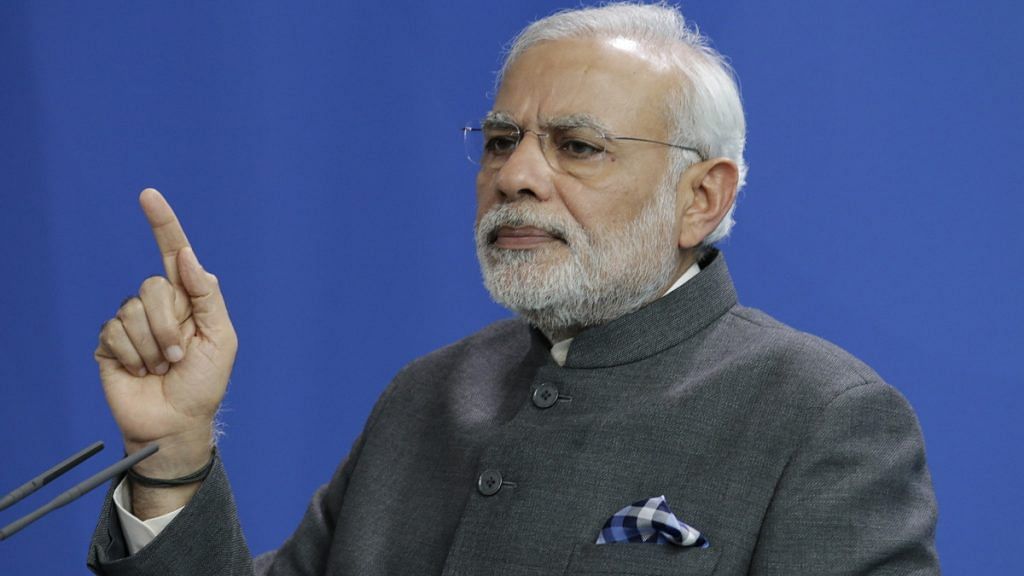Modi presents a softer version of himself but leaves us no wiser on the anxieties of the economy.
Chaliye Puducherry ko vanakkam,” had become shorthand for Prime Minister Narendra Modi’s inability to take tough, unscripted questions. During a video interaction with Bharatiya Janata Party (BJP) workers, the prime minister was stumped when a worker asked him if the middle class was going to get any benefits for bearing the tax burden.
There were reports that from now on, questions by BJP workers in these video interactions are going to be screened—reports the BJP denied.
The PM’s interview to news agency ANI saw its editor Smita Prakash ask him almost all the tough questions anyone would have asked. This was surprising not only because most of his interviewers ask him leading questions that give him an opportunity only to praise himself and his government. The tough questions were even more surprising since ANI is seen as being rather friendly towards the BJP.
What was not surprising is the prime minister answered the tough questions with such alacrity that it seemed he knew the questions in advance. In other words, it came across as a scripted tough interview intended to give out the impression that the PM is not afraid of hard questions. Puducherry ko vanakkam. There were no follow up questions but let’s not nitpick.
Also read: TV Prime Time is PM time: Was Narendra Modi interview a PR exercise?
Poor answers
As usual the prime minister suggests he cares more about the country than about winning elections. But his listing of achievements doesn’t explain why his party has lost all five states that held Assembly elections last month.
He sees Chhattisgarh as the only real defeat, explained by 15 years of anti-incumbency, but what does that do to his party’s stated aim of having the BJP win every seat from panchayat to Parliament and obliterate the opposition?
Well, he doesn’t want to do that anymore. He only wants an end to the Congress ‘culture’ of ‘Casteism, Dynastic politics, undemocratic, nepotism,’ as if these traits are not to be found in the BJP.
Nevertheless, the fact is that the BJP has made a climb-down from its days of seeking one-party domination. That itself is recognition of the decline of the Modi sentiment.
He compared demonetisation’s negative impact to the transition troubles of the liberalisation of India’s economy in 1991. But unlike liberalisation, thenote ban failed at its intended purpose of destroying black money. Turning this black money into white actually benefited those who were hoarding cash. On GST, similarly, Modi suggested things would take time to settle down.
But they couldn’t—shouldn’t it have been planned better in the first place?
Moreover, the prime minister didn’t have good answers to the big worries of India 2019: the collapse of the farming economy, the slowdown in credit and demand as well as rural wages, and the unprecedented growth in unemployment. On both politics and the economy, the PM’s answers didn’t leave us any wiser, let alone euphoric in the way that Modi’s words would in 2013-14.
The point that exemplifies Modi not having good answers to tough questions is the pollution in the Ganga. It was a major symbolic issue in his 2014 campaign. The Ganga is actually dirtier now, and the best Modi can say is he is ‘still working hard on it’.
Also read: The writing on the wall is clear: Welcome 2019, goodbye, Narendra Modi
Modi downplaying Modi
A change that comes through distinctly in the interview is Modi downplaying Modi—far from the talk of a 56-inch Modi pursuing Mission 272+. In the ANI interview, he spoke instead of ‘coalition dharma’. He said, “Our allies wish to grow and we too want them to grow. We do not want that we should grow at the cost of allies.”
That’s virtually admitting that a clear majority in 2019 is unlikely and the National Democratic Alliance will play a stronger role than it did in 2014.
2019 ‘is going to be Janta versus Gathbandhan. Modi is just a manifestation of public love and blessings,’ he said. Refusing to say it is Modi versus all, he put it this way: “This elections is going to be fought on who fulfils and takes forward the aspirations of the people and who stops these. Public is the decider.”
The attempt at projecting a soft image is also seen in the toning down of Hindutva. He scotched rumours of an untimely ordinance on Ram Mandir and condemned lynchings by cow vigilantes. 2014 was not a Hindutva election and Modi clearly recognises Hindutva hasn’t been adding the fence-sitter vote to his kitty.
But if Brand Modi has weakened, there are no answers on jobs and farmers’ distress, and Hindutva is not working, what exactly is the 2019 plank?
Also read: Modi wave isn’t waning & people are with me, PM Modi claims months before elections
Surgical strikes
Two things that stand out in the public sentiment about Modi are the surgical strikes on Pakistan, and the PM’s foreign visits, which have been sold as a matter of uplifting India’s stature on the world stage.
With the excuse of explaining why he travelled abroad so much, he said, “Earlier, when PM used to go, nobody used to notice at the place they would arrive, even the place from where they departed. My visits are noticed because I interact with people and take decisions.”
And then, deviating from the format of posing tough questions, Smita Prakash gave Modi the chance to brag about the army’s surgical strikes against suspected militants in Pakistan. That’s the only question where Modi came out with flying colours. “Success or failure, come back before sunrise,” Modi says he told the army. “Even if [you] fail, come back. I won’t let my soldiers to die.”
